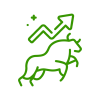Background
In economics, the concept of cycles is integral to understanding how various economic activities and variables oscillate over time. Cycles can manifest in different parts of the economy, influencing sectors such as production, credit, and trade, among others.
Historical Context
Over the centuries, economists have observed patterns of fluctuation in economic activities. The study of these repeated sequences has led to the development of various types of economic cycle theories and has become a significant part of economic analysis.
Definitions and Concepts
Business Cycle
A business cycle refers to the fluctuations in economic activity that an economy experiences over a period. It consists of expansions (upturns), peaks, contractions (downturns), and troughs.
Credit Cycle
The credit cycle captures the expansion and contraction of access to credit in an economy. This cycle affects borrowing, investment, and spending behaviors.
Kondratieff Cycle
Named after the Russian economist Nikolai Kondratieff, this long-term cycle lasts about 50-60 years and involves long phases of high economic growth and periods of stagnation.
Life Cycle
In individual or business lifecycle economics, this term refers to various stages that economic agents undergo, such as start-up phases, growth, maturity, and eventual exit or decline.
Stop-Go Cycle
This type of cycle reflects government fiscal and monetary policies that alternate between expansionary and contractionary actions, often in response to economic conditions.
Trade Cycle
Synonymous with the business cycle, this term describes the periodic fluctuations in economic activity related to trade, production, employment, and various other economic variables.
Major Analytical Frameworks
Classical Economics
In classical economics, cycles are largely seen as anomalies that eventually self-correct due to the self-regulating nature of markets.
Neoclassical Economics
Neoclassical theory also views cycles as temporary deviations from long-term equilibrium caused by random shocks or changes in external conditions.
Keynesian Economic
Keynesian economics places significant importance on government intervention to manage cycles, focusing on using fiscal and monetary policies to smooth out the fluctuations.
Marxian Economics
Marxian theory suggests that cycles are inherent in the capitalist mode of production, driven by contradictions and class struggles that result in periodic crises.
Institutional Economics
This school considers cycles as products of evolving institutional and social arrangements that influence economic behavior and structures.
Behavioral Economics
Behavioral economists highlight psychological factors and irrational behavior of investors and consumers as key drivers of economic cycles.
Post-Keynesian Economics
Post-Keynesian perspectives often stress the role of demand, the financial system, and institutions as crucial in understanding cycles.
Austrian Economics
Austrian cycles are linked to the theory of malinvestment, often resulting from artificial distortions in interest rates making some investments unviable.
Development Economics
Cyclic phenomena in developing economies may be induced by a development pathway, structural changes, or external shocks affecting the macro environment.
Monetarism
Monetarist theories contend that cycles are heavily influenced by changes in the money supply, with a strong emphasis on controlling inflation to manage cycles.
Comparative Analysis
Economic Responses
Various schools offer differing solutions to address cycles, from non-interventionist approaches to significant involvement of state mechanisms.
Predictive Power
Theories diverge in their efficacy to predict cyclical behaviors, with some offering detailed frameworks while others remain more descriptive.
Case Studies
The Great Depression
A deep analysis of cyclic theories during one of the most severe economic downturns to understand contributing factors and policies implemented in response.
The 2008 Financial Crisis
Investigating the various cycles, notably the credit cycle, and their implications leading up to the crisis.
Suggested Books for Further Studies
- “Business Cycles: History, Theory and Investment Reality” by Lars Tvede
- “The Little Book of Economics – How The Economy Works in The Real World” by Greg Ip
- “The Power of Economic Ideas: Keynes And The Revolution” by Peter Hall
Related Terms with Definitions
- Recession: A period of temporary economic decline marked by falling GDP and rising unemployment.
- Expansion: A phase of the business cycle where economic activity increases, leading to growth in jobs, income, and production.
- Peak: The point in the business cycle at which economic activity reaches its highest before a downturn.
- Trough: The lowest point in the business cycle, signaling the end of a contraction and the transition to an expansion.
